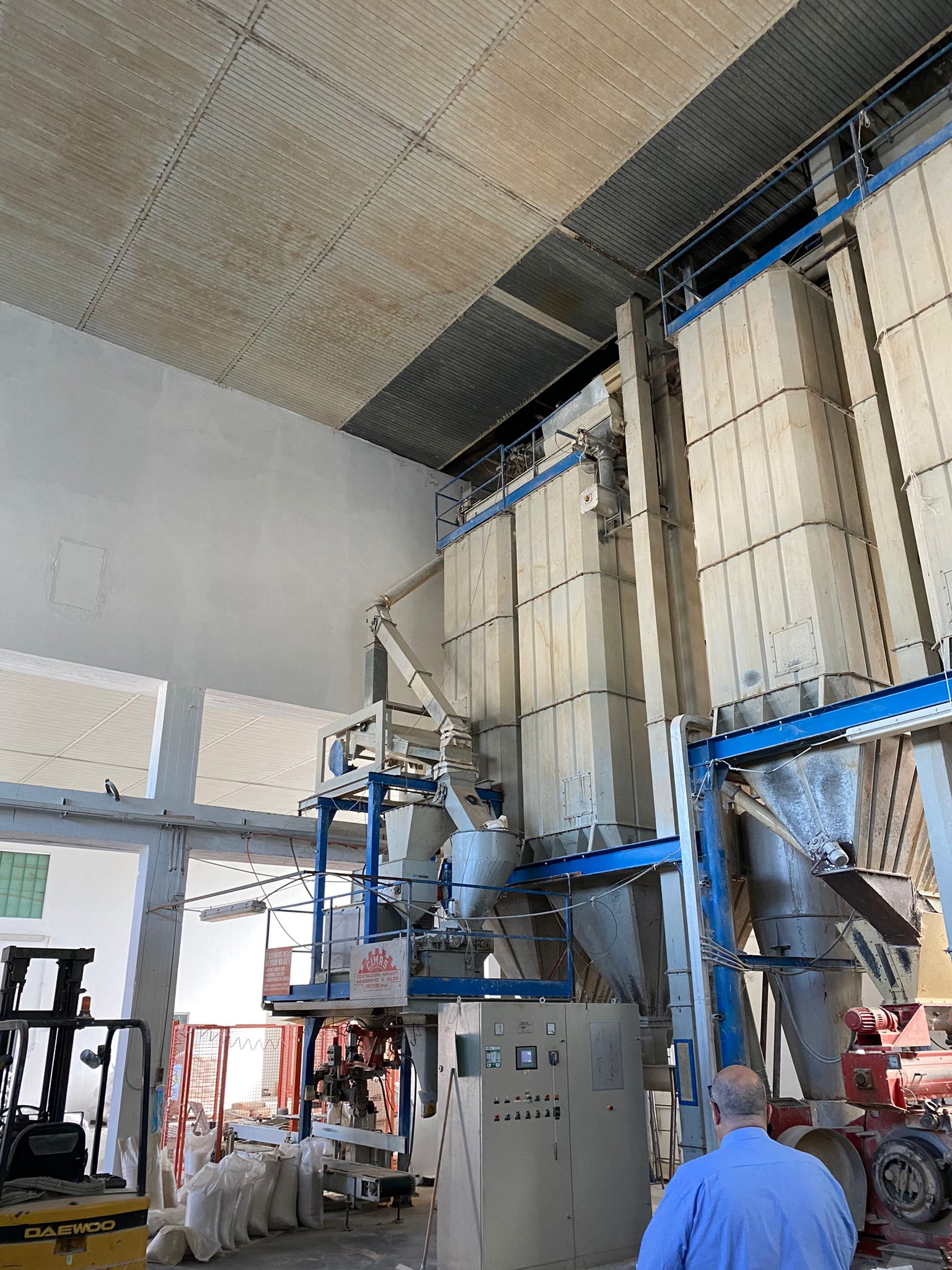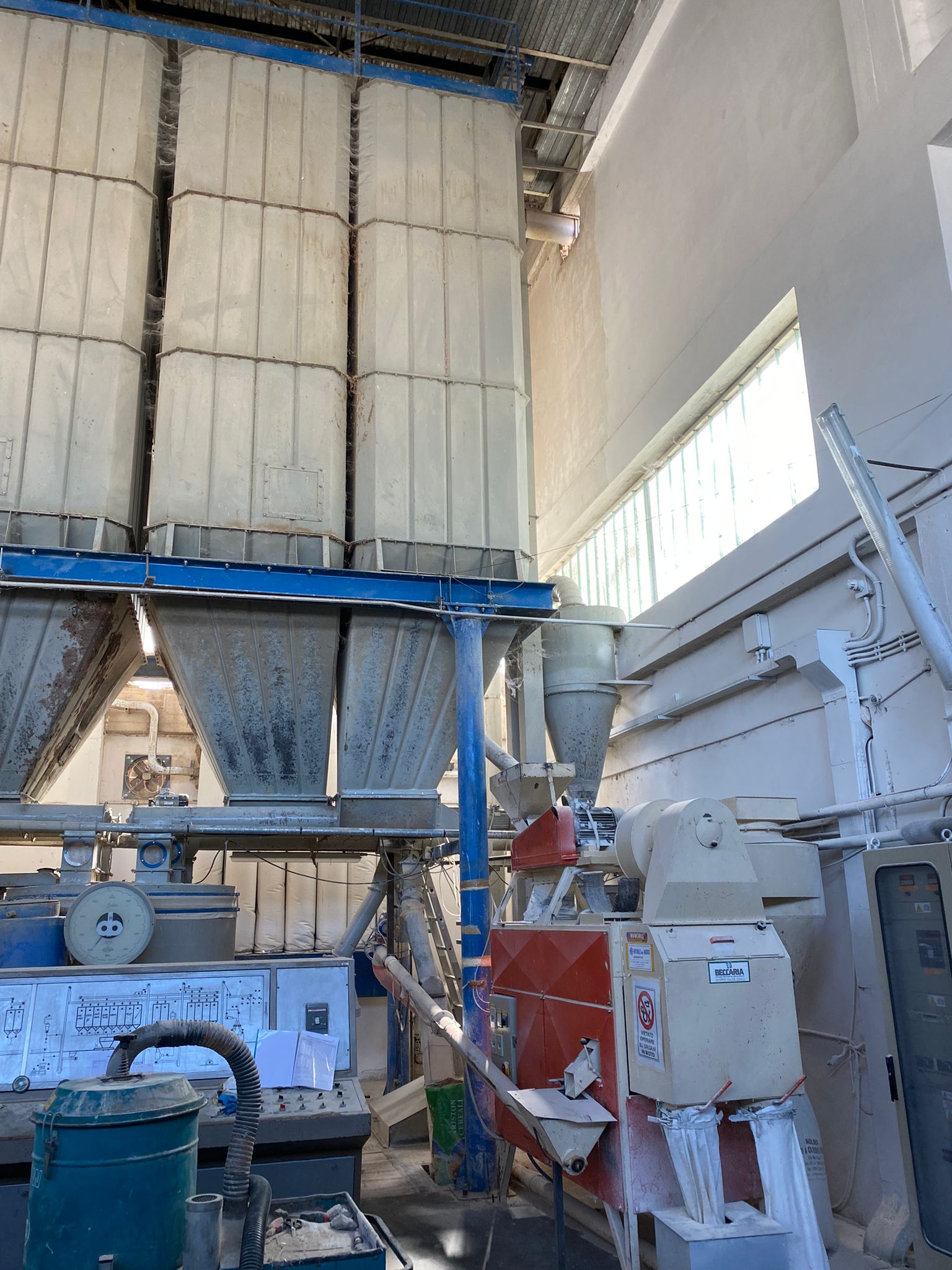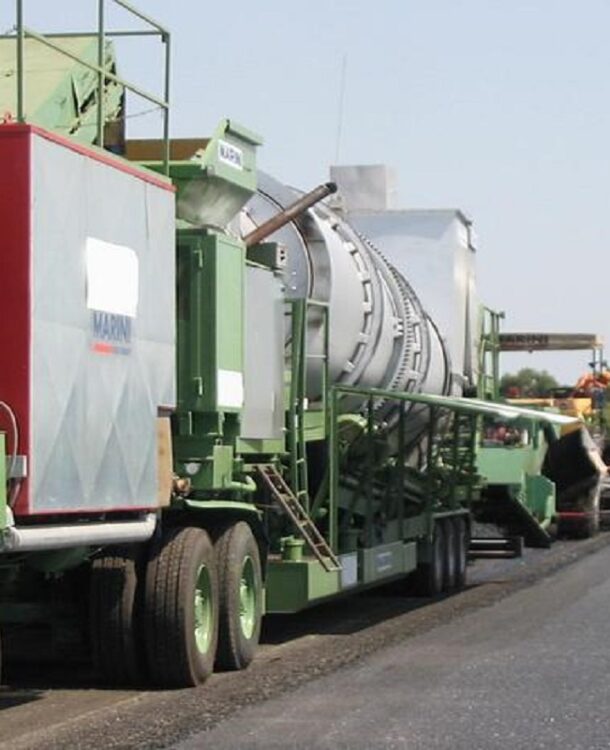

Project Information
- Project : USED FEED MILL
- Category : Used Machine
- Date : February 20, 2023
- Status : Completed
ABOUT THE PROJECT
 USED FEED MILL
USED FEED MILL
Recipes are managed through a PC. The components are weighed in progression in a special 1,000 kg container based on the type of feed you want to produce.
Once the “mixed” has been weighed, it passes into a first mixer with two reels which has the function of rendering homogeneous the grain in order to have a grinding without consumption peaks due to the different consistency of the cereals (eg barley vs. soy flour) in addition to having a first homogenization of the product.
The mixers were replaced indicatively in 2003/2005, custom-built by a local artisan company.
Once the production process is finished, the above mixer discharges the product into a container above the mills, so as to be able to continuously receive the subsequent production.
We then move on to the grinding phase, with two mills equipped with a 125 hp engine each; in one of them an additional 60 hp engine for the coarse grinding of some productions. The mills are older but revisioned in early 2000.
Once the grinding has been carried out, the premix is sucked into a further container, and on the way, they come
added liquid products are also managed by PCs and microelements such as vitamins and additives.
The products are PLP and were also assembled in the early 2000s.
By gravity, the premix descends into the actual mixer, equipped with load cells, for the definitive homogenization of the required product.
The grinding and mixing time is about 4 minutes per cycle of 1000 kg of product, for a maximum capacity hourly of 10 tons / h., a time that obviously varies according to the ingredients of the recipe and the particle size required.
This mixer was also produced at the same time as the previous one by local artisans.
All production is managed by a PC with SIEMENS sensors and components.
 MOULIN D’ALIMENTATION D’OCCASION
MOULIN D’ALIMENTATION D’OCCASION
Les recettes sont gérées via un PC. Les composants sont pesés au fur et à mesure dans un conteneur spécial de 1 000 kg en fonction du type d’aliment que vous souhaitez produire.
Une fois le « mixé » pesé, il passe dans un premier mélangeur à deux bobines qui a pour fonction de rendre homogène le grain afin d’avoir un broyage sans pics de consommation dus à la consistance différente des céréales (ex : orge vs soja farine) en plus d’avoir une première homogénéisation du produit.
Les mélangeurs ont été remplacés à titre indicatif en 2003/2005, construits sur mesure par une entreprise artisanale locale.
Une fois le processus de production terminé, le mélangeur ci-dessus décharge le produit dans un conteneur au-dessus des moulins, de manière à pouvoir recevoir en continu la production suivante.
On passe ensuite à la phase de broyage, avec deux moulins équipés d’un moteur de 125 ch chacun ; dans l’un d’eux un moteur supplémentaire de 60 ch pour le broyage grossier de certaines productions. Les moulins sont plus anciens mais révisés au début des années 2000.
Une fois le broyage effectué, le prémélange est aspiré dans un autre récipient, et en chemin il arrive
produits liquides ajoutés également gérés par des PC et des microéléments tels que des vitamines et des additifs.
Les produits sont PLP et également assemblés au début des années 2000.
Par gravité, le prémélange descend dans le malaxeur proprement dit, équipé de pesons, pour le definitive homogénéisation du produit recherché.
Le temps de broyage et de mélange est d’environ 4 minutes par cycle de 1000 kg de produit, pour une capacité horaire maximale de 10 tonnes/h., un temps qui varie évidemment selon les ingrédients de la recette et la granulométrie requise.
Ce mélangeur a également été produit en même temps que le précédent par des artisans locaux.
Toute la production est gérée par un PC avec capteurs et composants SIEMENS.
 MANGIMIFICO USATO
MANGIMIFICO USATO
PROCESSO INDUSTRIALE E MACCHINARI PRESENTI NEL MANGIMIFICIO CANALI
Tramite pc vengono gestite le ricette. I componenti vengono pesati in progressione in apposito contenitore da kg 1.000 in base al tipo di mangime che si vuole produrre.
Una volta pesata la “miscelata” la stessa passa in un primo miscelatore a due naspi che ha la funzione di rendere omogenea la granaglia al fine di avere una macinatura senza picchi di consumo dovuti alla diversa consistenza dei cereali (es. orzo vs. farina di soya) oltre al fatto di avere una prima omogeneizzazione del prodotto.
I miscelatori sono stati sostituiti indicativamente nel 2003/2005, costruiti su misura da azienda artigiana locale.
Il miscelatore di cui sopra, terminato il processo produttivo, scarica il prodotto in un contenitore sopra ai mulini, in modo da poter ricevere in continuo la successiva produzione. Si passa poi alla fase di macinazione, con due mulini dotati di motore da 125 hp ciascuno; in uno di essi è montato un ulteriore motore da hp 60 per la macinatura grossolana di alcune produzioni.
I mulini sono meno recenti ma revisionati anche questi nei primi anni 2000.
Una volta effettuata la macinatura, la premiscela viene aspirata in un ulteriore contenitore, e nel tragitto vengono aggiunti i prodotti liquidi anch’essi gestiti da pc e i microelementi come vitamine e additivi.
I prodotti sono PLP e montati anch’essi nei primi anni 2000.
Per caduta la premiscela scende nel miscelatore vero e proprio, dotato di celle di carico, per la definitiva omogenenizzazione del prodotto richiesto.
Il tempo di macinatura e miscelazione è di circa 4 minuti per ciclo da 1000 kg di prodotto, per una capacità massima oraria di 10 ton/h., tempo che varia ovviamente in base agli ingredienti della ricetta e alla granulometria richiesta.
Anche questo miscelatore è stato prodotto contemporaneamente a quello precedente da artigiani locali.
Tutta la produzione è gestita da PC con sensori e componenti SIEMENS.
Related Projects










